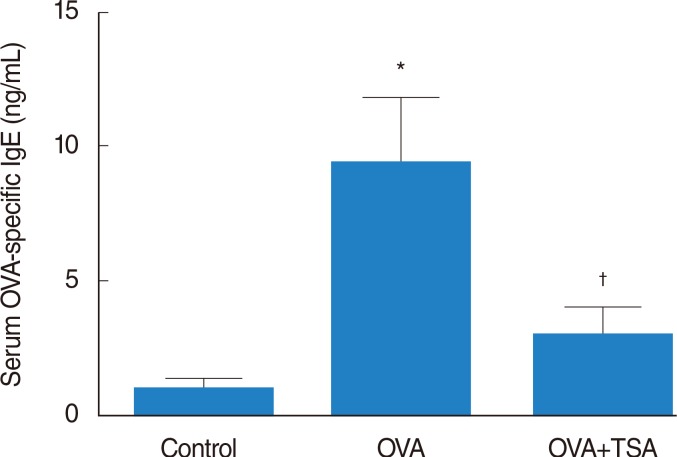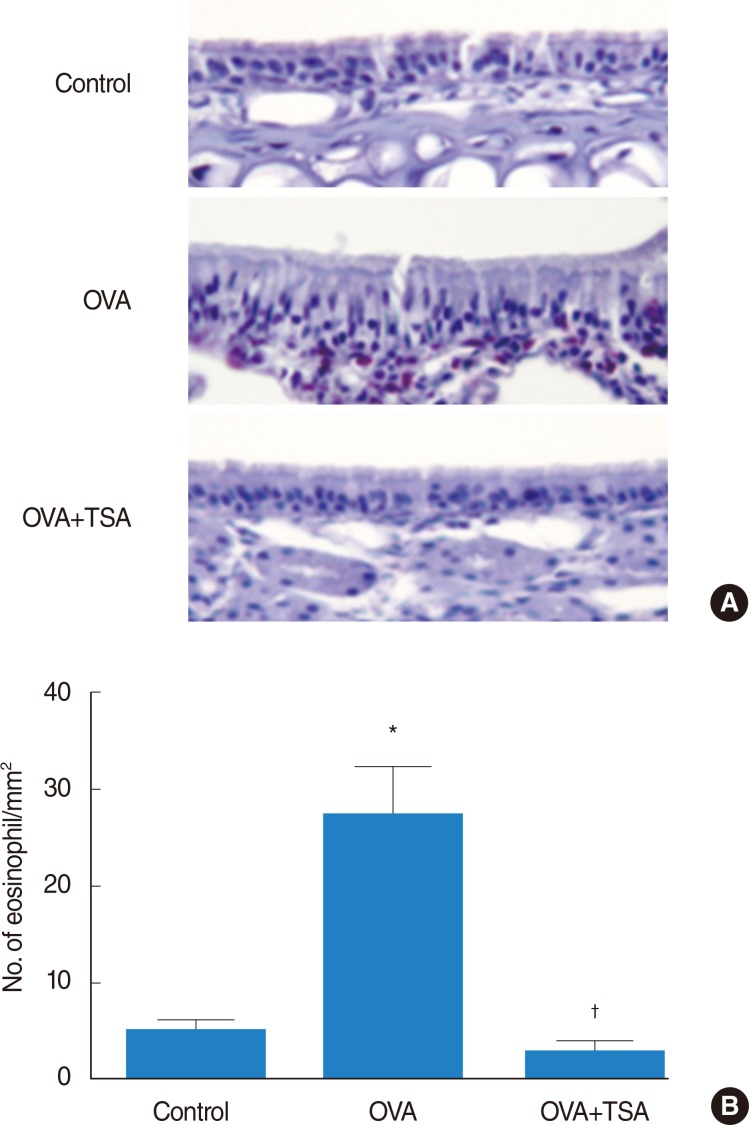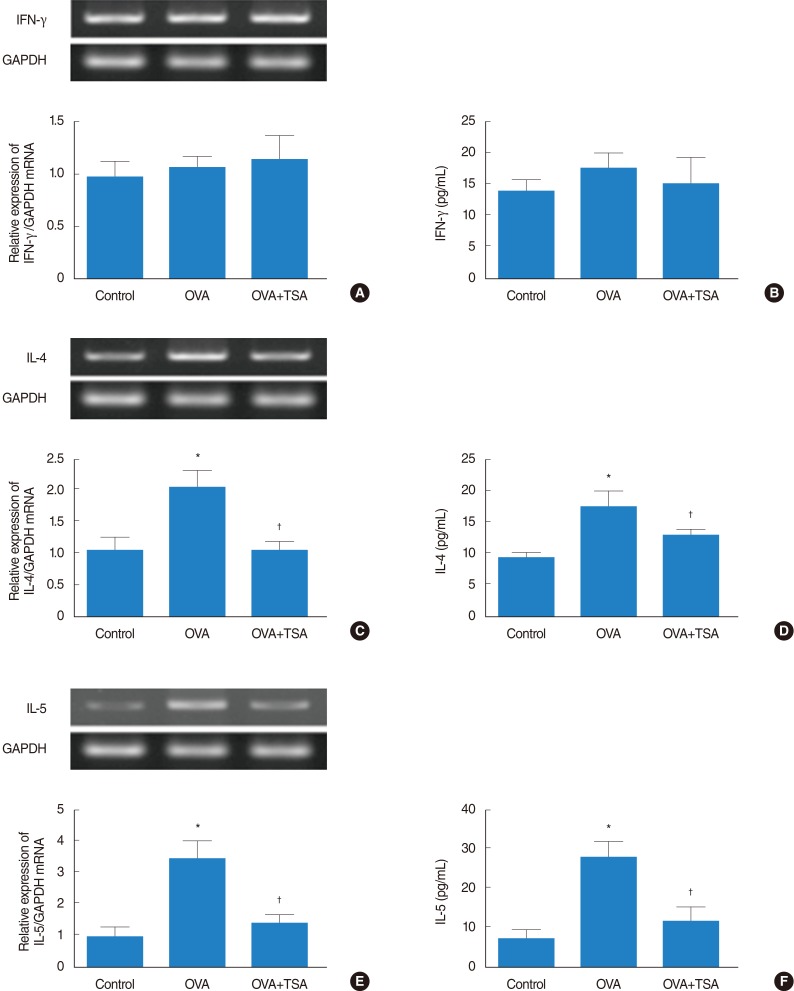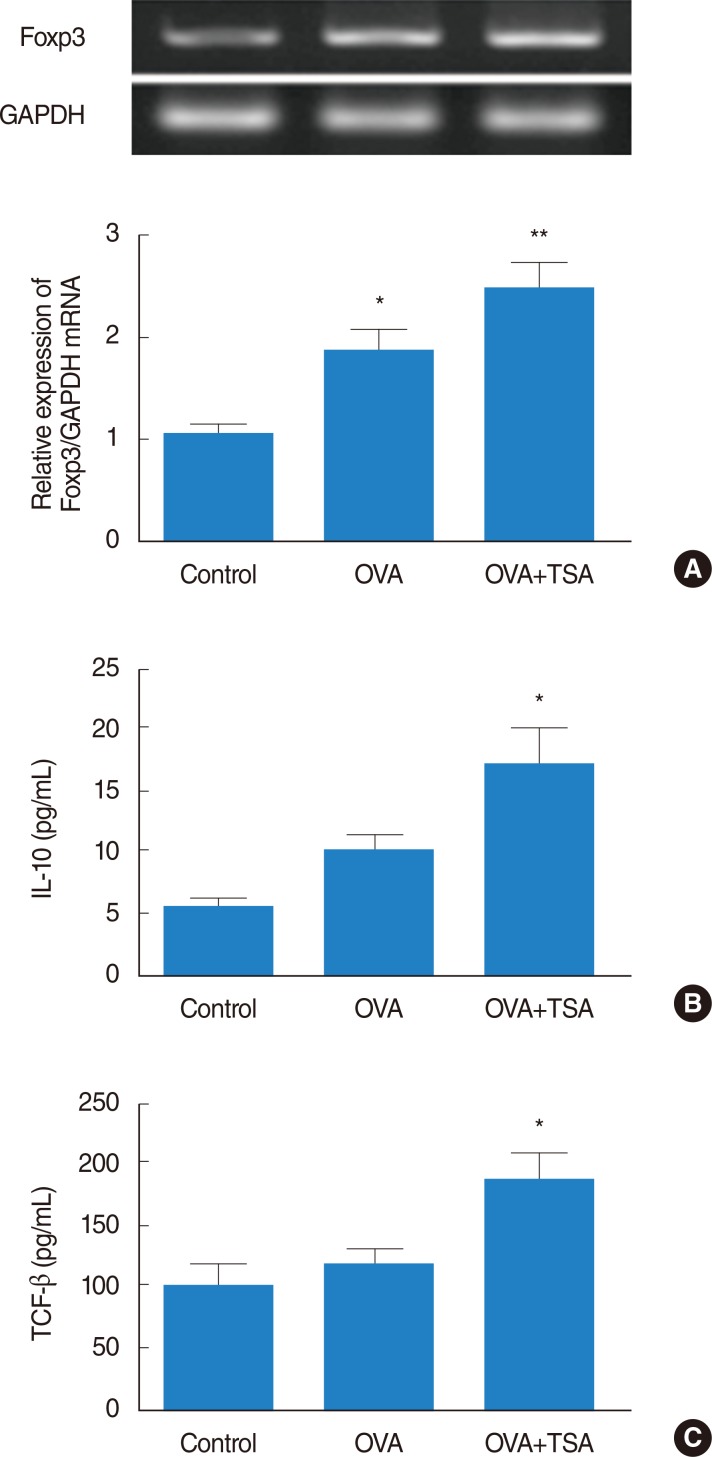Clin Exp Otorhinolaryngol.
2015 Sep;8(3):243-249. 10.3342/ceo.2015.8.3.243.
Antiallergic Effects of Trichostatin A in a Murine Model of Allergic Rhinitis
- Affiliations
-
- 1Brain Korea 21 Plus for Biomedical Science, Seoul, Korea. lhman@korea.ac.kr
- 2Institute for Medical Devices Clinical Trial Center, Seoul, Korea.
- 3Department of Otorhinolaryngology-Head and Neck Surgery, Korea University College of Medicine, Seoul, Korea.
- KMID: 2117519
- DOI: http://doi.org/10.3342/ceo.2015.8.3.243
Abstract
OBJECTIVES
Trichostatin A (TSA), an inhibitor of histone deacetylase, has been shown to play an important role in attenuating asthmatic inflammation. However, the effect of TSA in allergic rhinitis is not known. The aims of this study were to investigate the effect of TSA on allergic nasal inflammation and on the induction of regulatory T cells in a murine model of allergic rhinitis.
METHODS
BALB/c mice were sensitized intraperitoneally with ovalbumin (OVA) and then challenged intranasally with OVA. TSA (1 mg/kg) was given to the treatment group, and multiple parameters of allergic responses were evaluated to determine the effects of TSA on allergic rhinitis. Allergic nasal symptom scores, including frequency of rubbing and sneezing, were checked. Eosinophil infiltrations were stained with Chromotrope 2R, and the expression levels of OVA-specific IgE, T-helper 1 (Th1) cytokine (interferon-gamma [IFN-gamma]), Th2 cytokines (interleukin [IL] 4 and IL-5) and Treg (Foxp3, IL-10, and transforming growth factor-beta [TGF-beta]) were measured by quantitative reverse transcription-polymerase chain reaction or enzyme-linked immunosorbent assay.
RESULTS
TSA reduced the scores of allergic nasal symptoms and the amount of eosinophil infiltration into the nasal mucosa. TSA suppressed OVA-specific IgE levels and reduced expression of the IL-4 and IL-5. However, the expression of IFN-gamma was unchanged in the treatment group. The levels of Foxp3, IL-10, and TGF-beta were increased in pretreatment with TSA as compared to control group.
CONCLUSION
This study shows that TSA induced antiallergic effects by decreasing eosinophilic infiltration and Th2 cytokines in a murine model of allergic rhinitis via regulation of Tregs. Thus, TSA may be considered a potentially therapeutic agent in treating allergic rhinitis.
Keyword
MeSH Terms
-
Animals
Cytokines
Enzyme-Linked Immunosorbent Assay
Eosinophils
Histone Deacetylases
Immunoglobulin E
Inflammation
Interleukin-10
Interleukin-4
Interleukin-5
Mice
Nasal Mucosa
Ovalbumin
Ovum
Rhinitis*
Sneezing
T-Lymphocytes, Regulatory
Transforming Growth Factor beta
Cytokines
Histone Deacetylases
Immunoglobulin E
Interleukin-10
Interleukin-4
Interleukin-5
Ovalbumin
Transforming Growth Factor beta
Figure
Cited by 1 articles
-
Strain-Specific Differences in House Dust Mite (
Dermatophagoides farinae
Ki-Il Lee, Jun-Sang Bae, Eun Hee Kim, Ji Hye Kim, Lele Lyu, Young-Jun Chung, Ji-Hun Mo
Clin Exp Otorhinolaryngol. 2020;13(4):396-406. doi: 10.21053/ceo.2019.01837.
Reference
-
1. Hellings PW, Ceuppens JL. Mouse models of global airway allergy: what have we learned and what should we do next? Allergy. 2004; 9. 59(9):914–919. PMID: 15291897.
Article2. Jeffery PK, Haahtela T. Allergic rhinitis and asthma: inflammation in a one-airway condition. BMC Pulm Med. 2006; 11. 6(Suppl 1):S5. PMID: 17140423.
Article3. Melvin TA, Ramanathan M Jr. Role of innate immunity in the pathogenesis of allergic rhinitis. Curr Opin Otolaryngol Head Neck Surg. 2012; 6. 20(3):194–198. PMID: 22569404.
Article4. Yssel H, Groux H. Characterization of T cell subpopulations involved in the pathogenesis of asthma and allergic diseases. Int Arch Allergy Immunol. 2000; 1. 121(1):10–18. PMID: 10686504.
Article5. Possa SS, Leick EA, Prado CM, Martins MA, Tiberio IF. Eosinophilic inflammation in allergic asthma. Front Pharmacol. 2013; 4. 4:46. PMID: 23616768.
Article6. Varga EM, Jacobson MR, Till SJ, Masuyama K, O'Brien F, Rak S, et al. Cellular infiltration and cytokine mRNA expression in perennial allergic rhinitis. Allergy. 1999; 4. 54(4):338–345. PMID: 10371092.
Article7. Bhavsar P, Ahmad T, Adcock IM. The role of histone deacetylases in asthma and allergic diseases. J Allergy Clin Immunol. 2008; 3. 121(3):580–584. PMID: 18234319.
Article8. Barnes PJ, Adcock IM, Ito K. Histone acetylation and deacetylation: importance in inflammatory lung diseases. Eur Respir J. 2005; 3. 25(3):552–563. PMID: 15738302.
Article9. Cho JS, Moon YM, Park IH, Um JY, Moon JH, Park SJ, et al. Epigenetic regulation of myofibroblast differentiation and extracellular matrix production in nasal polyp-derived fibroblasts. Clin Exp Allergy. 2012; 6. 42(6):872–882. PMID: 22239687.
Article10. Cho JS, Moon YM, Park IH, Um JY, Kang JH, Kim TH, et al. Effects of histone deacetylase inhibitor on extracellular matrix production in human nasal polyp organ cultures. Am J Rhinol Allergy. 2013; 1. 27(1):18–23. PMID: 23406592.
Article11. Akdis M, Verhagen J, Taylor A, Karamloo F, Karagiannidis C, Crameri R, et al. Immune responses in healthy and allergic individuals are characterized by a fine balance between allergen-specific T regulatory 1 and T helper 2 cells. J Exp Med. 2004; 6. 199(11):1567–1575. PMID: 15173208.
Article12. Meiler F, Zumkehr J, Klunker S, Ruckert B, Akdis CA, Akdis M. In vivo switch to IL-10-secreting T regulatory cells in high dose allergen exposure. J Exp Med. 2008; 11. 205(12):2887–2898. PMID: 19001136.
Article13. Sakaguchi S, Wing K, Yamaguchi T. Dynamics of peripheral tolerance and immune regulation mediated by Treg. Eur J Immunol. 2009; 9. 39(9):2331–2336. PMID: 19662638.
Article14. Shim JJ, Dabbagh K, Ueki IF, Dao-Pick T, Burgel PR, Takeyama K, et al. IL-13 induces mucin production by stimulating epidermal growth factor receptors and by activating neutrophils. Am J Physiol Lung Cell Mol Physiol. 2001; 1. 280(1):L134–L140. PMID: 11133503.
Article15. Frew AJ. The immunology of respiratory allergies. Toxicol Lett. 1996; 8. 86(2-3):65–72. PMID: 8711778.
Article16. Stassen M, Jonuleit H, Muller C, Klein M, Richter C, Bopp T, et al. Differential regulatory capacity of CD25+ T regulatory cells and preactivated CD25+ T regulatory cells on development, functional activation, and proliferation of Th2 cells. J Immunol. 2004; 7. 173(1):267–274. PMID: 15210784.17. Curotto de Lafaille MA, Muriglan S, Sunshine MJ, Lei Y, Kutchukhidze N, Furtado GC, et al. Hyper immunoglobulin E response in mice with monoclonal populations of B and T lymphocytes. J Exp Med. 2001; 11. 194(9):1349–1359. PMID: 11696599.18. Suto A, Nakajima H, Kagami SI, Suzuki K, Saito Y, Iwamoto I. Role of CD4(+) CD25(+) regulatory T cells in T helper 2 cell-mediated allergic inflammation in the airways. Am J Respir Crit Care Med. 2001; 8. 164(4):680–687. PMID: 11520737.19. Jaffar Z, Sivakuru T, Roberts K. CD4+CD25+ T cells regulate airway eosinophilic inflammation by modulating the Th2 cell phenotype. J Immunol. 2004; 3. 172(6):3842–3849. PMID: 15004191.20. Leoni F, Zaliani A, Bertolini G, Porro G, Pagani P, Pozzi P, et al. The antitumor histone deacetylase inhibitor suberoylanilide hydroxamic acid exhibits antiinflammatory properties via suppression of cytokines. Proc Natl Acad Sci U S A. 2002; 3. 99(5):2995–3000. PMID: 11867742.
Article21. Xu WS, Parmigiani RB, Marks PA. Histone deacetylase inhibitors: molecular mechanisms of action. Oncogene. 2007; 8. 26(37):5541–5552. PMID: 17694093.
Article22. Choi JH, Oh SW, Kang MS, Kwon HJ, Oh GT, Kim DY. Trichostatin A attenuates airway inflammation in mouse asthma model. Clin Exp Allergy. 2005; 1. 35(1):89–96. PMID: 15649272.
Article23. Guo X, Jie Y, Ren D, Zeng H, Zhang Y, He Y, et al. Histone deacetylase inhibitors promote mice corneal allograft survival through alteration of CD4+ effector T cells and induction of Foxp3+ regulatory T cells. Cell Immunol. 2012; May-Jun. 277(1-2):8–13. PMID: 22776176.
- Full Text Links
- Actions
-
Cited
- CITED
-
- Close
- Share
- Similar articles
-
- Allergic Rhinitis Mouse Model
- The Inhibitory Effect of BCG on the Allergic Inflammation in House Dustmite-Induced Mouse
- Inhibition of Allergic Response by CpG Motif Immunostimulatory Oligodeoxynucleotide in a Murine Model of Allergic Rhinitis
- Clincal Effect of Ketotifen in Allergic Rhinitis
- Diagnosis of Allergic Rhinitis







